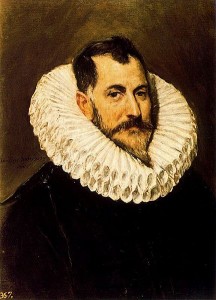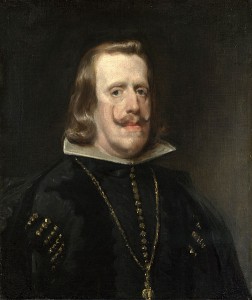By Elizabeth A. Lehfeldt (W&M Regular Contributor)
Writing in 1637, the Marquis of Careaga deplored the “delicate and womanly” fashions that enraptured Spanish men. He warned that these indulgences “overthrew their spirits, unnerved their determination, weakened their energy, and diminished their manly vigor.”
We might wonder what sort of fashions could inspire such vitriol. A particular item stood at the heart of his comments and those of other moralists: a ruff. Specifically, a Spanish variation on the ruff known as the cuello. The cuello, represented here in a portrait by El Greco, had become an object of excess.  This collar was several inches high, tinted with powders, and often decorated with fancy threads. And it had to be washed and starched daily to maintain its appearance. By the early seventeenth century, some tried to elevate their cuellos even further, using an undergirding support known as an alçacuello. Thus, the cuello came to embody a host of moralizing complaints that ranged from foreign policy to the economy to fears of compromised masculinity. To begin with, the dyes used to tint them were imported from Spain’s enemy, the Dutch. Many argued that the nobility’s ducados would benefit Spain more if they were spent locally. Finally, the cuello violated the prevailing code of virtuous virility that prized moderation, control, and a sense of effortlessness in matters of style. If anything, the cuello screamed excess and effort. Everyone knew how labor-intensive their care and presentation was. Men who indulged in this fashion were often characterized as effeminate. Their inability to dress with moderation compromised their masculinity. At a time when Spain was engaged in military conflict across the globe, the “manly vigor” of its male citizens had serious political consequences.
This collar was several inches high, tinted with powders, and often decorated with fancy threads. And it had to be washed and starched daily to maintain its appearance. By the early seventeenth century, some tried to elevate their cuellos even further, using an undergirding support known as an alçacuello. Thus, the cuello came to embody a host of moralizing complaints that ranged from foreign policy to the economy to fears of compromised masculinity. To begin with, the dyes used to tint them were imported from Spain’s enemy, the Dutch. Many argued that the nobility’s ducados would benefit Spain more if they were spent locally. Finally, the cuello violated the prevailing code of virtuous virility that prized moderation, control, and a sense of effortlessness in matters of style. If anything, the cuello screamed excess and effort. Everyone knew how labor-intensive their care and presentation was. Men who indulged in this fashion were often characterized as effeminate. Their inability to dress with moderation compromised their masculinity. At a time when Spain was engaged in military conflict across the globe, the “manly vigor” of its male citizens had serious political consequences.
The crown, in fact, vigorously legislated against them. As early as 1594 it forbid the adornment of cuellos, specified a particular width for them, and that any decorative elements be white. Again, in 1600 it issued orders regarding the width of cuellos. Yet the fashion endured.  Ultimately, rather than modify their appearance, the crown abolished them completely in 1623. It presented as an alternative the low, flat collar of the valona. Even the king himself was not above this new rule as we can see here in Velázquez’ portrait of Philip IV (1621-1665). Not unlike today, seventeenth-century fashion was intensely political.
Ultimately, rather than modify their appearance, the crown abolished them completely in 1623. It presented as an alternative the low, flat collar of the valona. Even the king himself was not above this new rule as we can see here in Velázquez’ portrait of Philip IV (1621-1665). Not unlike today, seventeenth-century fashion was intensely political.
Elizabeth A. Lehfeldt is Chair and Professor of History at Cleveland State University. She writes on the history of gender in premodern Europe.
